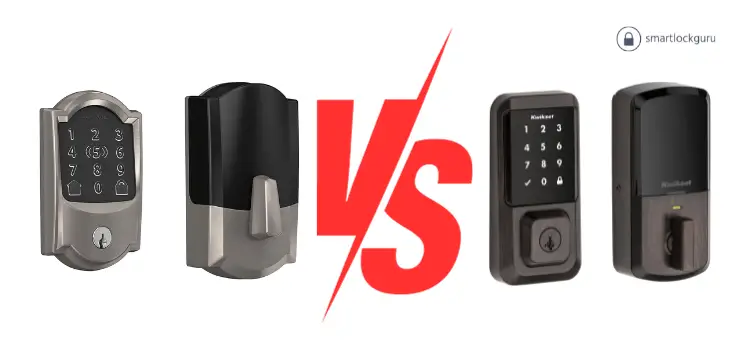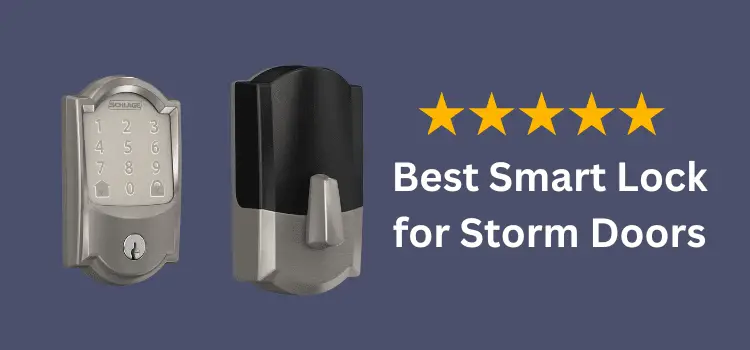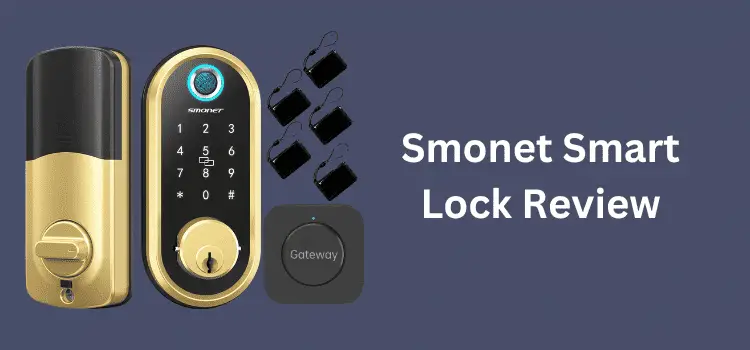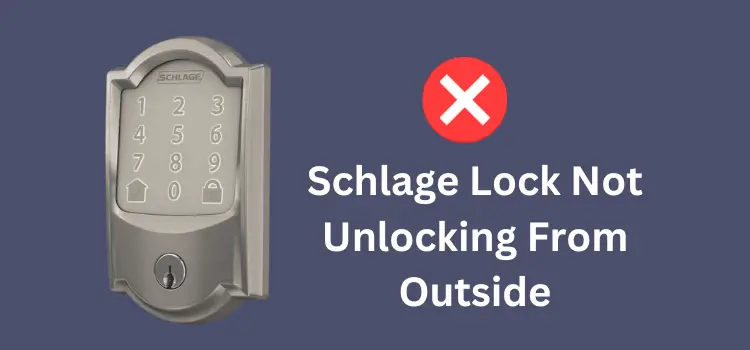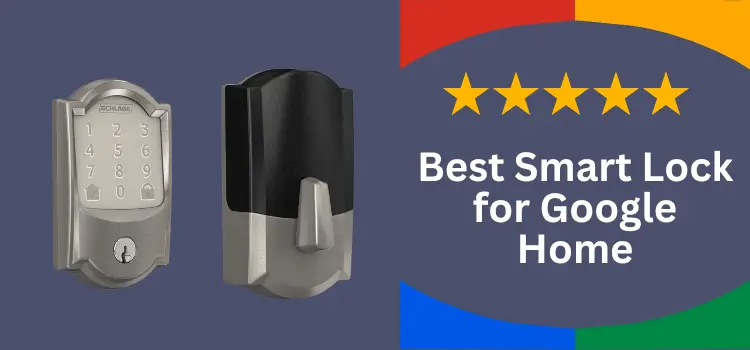Smart locks are becoming increasingly popular as the world becomes more digital. They provide increased security and convenience for homeowners, and with so many options available, deciding which one is the best fit for your house can be difficult.
We will examine two popular smart locks in this article: the Kwikset Halo and the Schlage Encode. We will go over the benefits and characteristics of each lock, and then help you decide which one will best suit your needs.
Table of Contents
ToggleDisclosure: Please note, as an Amazon Associate, I earn from qualifying purchases made through links in this post. This does not incur any additional cost to you.
Kwikset Halo vs Schlage Encode: A Comprehensive Comparison
The Kwikset Halo overview:
- Touchscreen as the Keypad
- Multiple user codes can be stored.
- There is no Z-Wave built-in alarm.
- No Flex-Lock
- Smart Home Integration: Compatible with a limited number of smart home systems
- There is no DoorSense.
- Grade 2 BHMA Certification
Schlage Encode overview
- Touchscreen with capacitive touchscreen keypad
- Up to 100 access codes can be stored.
- Built-in audio alarm to warn against attacks or forced entry.
- Z-Wave Plus compatible for smart home integration
- Flex-Lock (Switchable Modes): Yes (Change between automated and manual relocking)
- Smart Home Integration: Compatible with a limited number of smart home systems.
- Automatically locks or unlocks when you leave/return home.
- DoorSense Technology: Yes (the ability to detect if the door is open or closed).
- Grade 1 BHMA Certification
- Check the Most Recent Price
Kwikset Halo vs Schlage Encode: Key Features
| Feature | Kwikset Halo | Schlage Encode |
|---|---|---|
| Access Options | Keypad, app, traditional key | Keypad, app, voice control (Amazon Alexa, Google Assistant), traditional key |
| Connectivity | Wi-Fi Direct (no hub required) | Wi-Fi Direct (no hub required) |
| Installation | DIY-friendly, fits standard doors | DIY-friendly, fits standard doors |
| Security | SecureScreen (prevents fingerprint code detection), 256-bit encryption | Built-in alarm system, 256-bit encryption |
| App Features | Remote access, manage up to 250 user codes, view lock history | Remote access, manage up to 100 user codes, view lock history, voice control integration |
Wi-Fi
In comparison to Kwikset Halo vs Schlage Encode, both locks are Wi-Fi enabled and may be controlled remotely via a smartphone app. They can also be used in conjunction with smart home systems such as Amazon Alexa and Google Assistant.
Security
Both locks contain sophisticated security features such as built-in alarm sensors, auto locking, and tamper-proof mechanisms. Kwikset Halo also features proprietary Smart Key Security, which protects against lock picking and bumping.
Installation Ease
Both locks are simple to install and come with step-by-step instructions and video demonstrations. The unique installation procedure of Kwikset Halo eliminates the need for traditional screws and drilling.
Batteries
The battery life of the Kwikset Halo is claimed to be longer than that of the Schlage Encode. Halo requires four AA batteries that can last up to six months, whereas encode need four AA batteries that can last up to three months.
Low battery indications on both the Halo and the Encode alert users when it’s time to change the batteries. Some customers, however, claim that the Halo’s low battery indicator is more accurate and dependable.
Kwikset Halo vs Schlage Encode: In-Depth Comparison
Security and Reliability
When it comes to smart locks, security and reliability are paramount. Users need to trust that their locks will not only resist physical attacks but also withstand the challenges posed by digital threats. In comparison, Kwikset Halo vs Schlage Encode both have invested heavily in technology and design to provide users with peace of mind. Here’s how they stack up in terms of security and reliability.
Kwikset Halo: Innovative Security Features
Kwikset Halo incorporates several layers of security to ensure that your home stays protected. One of its standout features is the SmartKey Security™ technology, which allows homeowners to re-key their locks quickly and easily without a locksmith. This feature is particularly useful in preventing lock bumping and picking, common tactics used by intruders. Additionally, the Halo is BHMA Grade AAA certified, the highest rating for residential security, durability, and finish, ensuring a high level of protection against physical break-ins.
On the digital front, Kwikset Halo offers robust encryption and authentication protocols to secure the communication between the lock, your smartphone, and the cloud. This prevents unauthorized access and hacking attempts. Despite these advanced features, no technology is infallible. Users must stay vigilant and ensure their home Wi-Fi networks are secure and passwords are strong to prevent potential vulnerabilities.
Schlage Encode: Built to Last
Schlage Encode’s reputation for strength is not unfounded. With a legacy of over 100 years, Schlage has mastered the art of creating locks that are both physically and digitally secure. The Encode is ANSI/BHMA Grade 1 certified, the highest rating a residential lock can achieve. This certification guarantees top-notch resistance to forced entry, making it one of the most secure smart locks on the market.
In terms of digital security, Schlage Encode provides advanced encryption techniques and has been designed to work with secure home automation networks like Amazon Key and Ring. These integrations not only offer convenience but also ensure that your lock is operating within a secure and monitored ecosystem. Schlage’s focus on creating a robust lock is evident in its heavy-duty construction and tamper-resistant features, giving users confidence in their home’s security.
Reliability Concerns
Both Kwikset Halo and Schlage Encode are designed to be reliable and user-friendly. However, as with any technology, there are potential reliability concerns such as battery life, connectivity issues, and software glitches. It’s important for users to follow best practices, like regular battery checks and software updates, to ensure the longevity and effectiveness of their smart locks. Customer reviews and independent tests generally report high reliability for both models, but occasional issues can occur, as is the case with any sophisticated electronic device.
Conclusion
In summary, both Kwikset Halo and Schlage Encode offer robust security and reliability, but they do so with different emphases and technologies. Kwikset focuses on adaptability and re-keying technology, while Schlage emphasizes physical strength and high-grade certifications. Users should consider their specific security needs, the level of technological integration they’re comfortable with, and the general context of their home environment when choosing between these two reputable options.
Design and Aesthetics
The physical appearance of a smart lock is not just about aesthetics; it’s about integrating seamlessly with your home’s decor and reflecting your personal style. In comparison, Kwikset Halo vs Schlage Encode both have been designed with careful consideration of both form and function, but they exhibit distinct characteristics that might sway your preference.
Kwikset Halo: Modern and Adaptable
Kwikset Halo sports a sleek, contemporary design that aims to complement a wide range of door styles and home decors. Its smooth lines and modern interface are indicative of Kwikset’s approach to blending technology with everyday life seamlessly. Available in multiple finishes, including Satin Nickel and Venetian Bronze, the Halo provides options to match or accent your home’s hardware and color scheme. The keypad is well-lit and visibly clear, ensuring ease of use both day and night. The overall design of the Halo is unobtrusive yet stylish, making it a versatile choice for various homes.
Schlage Encode: Robust and Elegant
Schlage Encode, on the other hand, offers a more robust and traditional look, reflecting its heritage of strength and durability. The lock is designed to make a statement with its substantial build and bold geometric shapes. With finishes like Aged Bronze and Satin Nickel, the Encode is meant to not only secure your door but also add to its aesthetic appeal. The touchscreen keypad is fingerprint-resistant, ensuring that it remains sleek and clean over time. The Encode’s design exudes a sense of permanence and security, appealing to those who prefer a more classic, yet sophisticated, look on their doors.
Design Summary
In choosing between Kwikset Halo and Schlage Encode, consider the overall look and feel of your home. If your style leans towards modern and minimalistic, the Halo’s sleek, adaptable design might be more appealing. However, if you’re drawn to classic, sturdy aesthetics with a touch of elegance, the Schlage Encode could be the perfect fit. Ultimately, both locks offer a blend of style and security, but their distinct designs cater to different tastes and home decors.
Kwikset Halo vs Schlage Encode: Size difference
The Kwikset Halo is smaller than the Schlage Encode, making it a better choice for individuals with limited space.
Color Choices
The Kwikset Halo is available in three finishes: Satin Nickel, Venetian Bronze, and Iron Black, while the Schlage Encode is available in four: Matte Black, Satin Nickel, Aged Bronze, and Bright Chrome.
Keypad
The Schlage Encode features a physical keypad, whilst the Kwikset Halo features a capacitive touchscreen.
Integration of Smart Homes
Most smart home platforms, including Amazon Alexa, Google Assistant, and Apple HomeKit, are compatible with both locks. The Kwikset Halo, on the other hand, works with IFTTT and the Schlage Encode is Z-Wave compatible.
Battery Life
The Kwikset Halo has a longer battery life than the Schlage Encode, lasting up to 6 months as opposed to 3 months.
Price and Value for Money
When investing in a smart lock, the price is a significant factor, but it’s the value for money that often makes the final call. Both Kwikset Halo and Schlage Encode come with their own set of features and technologies, which are reflected in their pricing. Understanding what you’re getting for your money is key to making an informed decision.
Kwikset Halo: Affordable Flexibility
Kwikset Halo is generally priced more affordably than the Schlage Encode. The lower price point does not mean a compromise in quality or features but rather reflects Kwikset’s commitment to providing accessible security solutions. With features like SmartKey Security™, multiple access codes, and a user-friendly app, Halo offers a lot for its price. For homeowners looking for a reliable, feature-rich smart lock without breaking the bank, the Kwikset Halo presents a compelling value proposition.
Schlage Encode: Premium Security Investment
Schlage Encode is positioned at a higher price point, reflecting its Grade 1 security rating and robust build quality. With its advanced encryption, compatibility with major home automation systems, and a long-standing reputation for reliability, the Encode justifies its premium. It’s an investment in top-tier security and technological sophistication. For those willing to pay more for the added peace of mind and enhanced features, Schlage Encode offers excellent value.
Making the Right Choice
Ultimately, the value for money comes down to what you prioritize in a smart lock. If you want advanced security features and a robust build at a higher cost, Schlage Encode might be the right choice. However, if you prefer a more budget-friendly option that still offers a range of modern features, Kwikset Halo could be the way to go. Both locks provide a good balance of price and performance, but your specific needs and budget will dictate the best option for you.
Schlage Encode:
Kwikset Halo:
FAQs about Kwikset Halo vs Schlage Encode
- Are the Kwikset halo and Schlage encode echo plus compatible?
Yes, the Echo Plus is compatible with both the Kwikset Halo and the Schlage Encode. The Alexa app on your Echo Plus device allows you to operate and manage your smart lock. However, before purchasing any smart home gadgets, make sure to check the compatibility list on the manufacturer’s website to verify compatibility with your current ecosystem. - Do the Kwikset Halo and Schlage Encode have an auto-lock feature?
Yes, both the Kwikset Halo and the Schlage Encode include auto-locking mechanisms. The auto-lock feature locks the door after a certain length of time, ensuring that your door is always secure. You can adjust the time period for the auto-lock feature to suit your needs. - Will a pre-programmed code still work if the power goes out?
In general, if a pre-programmed code is stored in a smart lock’s memory and a power outage occurs, the code may still function as long as the lock’s backup power source (e.g., battery) remains functioning. Backup power options allow the Schlage Encode and Kwikset Halo to function during a power loss. For more information, consult the user manual for the individual smart lock or contact the manufacturer. - Can I operate the lock from a different country?
Yes, the Kwikset Halo vs Schlage Encode both support remote access from another country provided you have an active internet connection and a compatible smart device such a smartphone or tablet.
To remotely access and control the lock, utilize the manufacturer’s app or a compatible smart home hub, such as locking or unlocking the door or managing user codes. However, you must check that the lock is compatible with the network standards and protocols in the country from which you will access it.
To avoid illegal access, it is also suggested that you choose a strong and secure password and enable two-factor authentication. - Can I have two of these in my house, one for the front door and one for the back door?
Yes, you can have two Schlagle Encode or Kwikset Halo smart locks installed in your home, one for the front door and one for the back door. Both locks can be controlled by the same app or by using different access codes or keys for each lock. You would, however, need to buy two additional smart locks for each door. - Do Kwikset Halo and Schlage Encode require a hub to connect to Wi-Fi?
No, when comparing Kwikset Halo vs Schlage Encode, you’ll find that both smart locks are designed to connect directly to your Wi-Fi network, eliminating the need for an external hub. - Which smart lock is more user-friendly, Kwikset Halo or Schlage Encode?
Both Kwikset Halo vs Schlage Encode are praised for their user-friendly installation and operation. Your choice depends on your preference for specific features, such as Schlage Encode’s voice control capabilities or Kwikset Halo’s high user code capacity. - Which lock is better for a smart home setup, Kwikset Halo or Schlage Encode?
When considering Kwikset Halo vs Schlage Encode for smart home setups, Schlage Encode might be the better choice due to its extensive compatibility with various smart home ecosystems, including Amazon Alexa and Google Assistant.
Best Overall
In the Kwikset Halo vs Schlage Encode debate, Schlage Encode stands out as the best overall choice. It excels in security with its built-in alarm system and advanced encryption, offers versatile access through keypad, app, and smart home integration, and boasts durable construction. Its user-friendly setup, coupled with broad compatibility with smart ecosystems like Amazon Alexa and Google Assistant, makes it a superior pick for those seeking convenience and reliability in their smart home security solutions.
Conclusion of Kwikset Halo vs Schlage Encode Debate
Finally, Schlage Encode and Kwikset Halo are two of the best smart lock solutions on the market. Both have unique features, such as voice control and auto-locking, to improve home security.
While Schlage Encode costs extra, it provides greater encryption and is compatible with a broader range of smart home systems. Kwikset Halo, on the other hand, is a more economical choice that is simple to install and use.
Finally, the choice between the two will be determined by your personal demands and tastes. Regardless of which option you choose, upgrading to a smart lock is a prudent investment in your home’s security.
You might also like:
1- Kwikset 917 vs Kwikset 955 – A Comprehensive Comparison
2- Defiant vs Kwikset: A Detailed Smart Lock Showdown
3- Level Lock vs August: A Detailed Comparison for the Smart Home Enthusiast
4- Yale vs Schlage Smart Lock: A Detailed Comparison
5- August Smart Lock Pro vs August Smart Lock: A Not-So-Typical Guide

